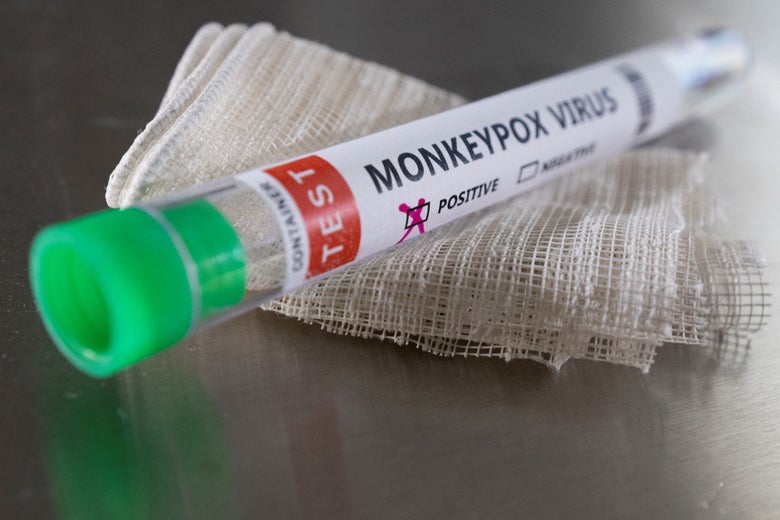
When news broke that monkeypox appears to be disproportionately affecting gay and bisexual men, Jih-Fei Cheng, associate professor of feminist, gender, and sexuality studies at Scripps College, thought: “Here we go again.” For Cheng and many others, the association of an emerging infectious disease with gay and bisexual men starkly recalled the early days of the HIV/AIDS epidemic, in which little was known about the condition beyond its impact on the queer community—an observation that led to its being called “gay cancer” for a time.
Advertisement
As of Friday, about 300 cases have been reported in the U.S. and Europe, and many countries have reported that all or nearly all of these cases have been in gay and bisexual men. Many of the men affected seem to have contracted monkeypox at events that were initially reported as “raves” but were in fact a 10-day gay pride event in the Canary Islands and a five-day fetish festival in Belgium. A gay sauna in Madrid may also have been a major transmission site.
Advertisement
Advertisement
Advertisement
When this link became clear, health officials responded swiftly. On Monday, John Brooks, head of the Epidemiology Research Team in the CDC’s Division of HIV/AIDS Prevention, made an explicit appeal to gay and bisexual men in a news briefing. On Tuesday, the gay dating app Grindr, in partnership with local health agencies, displayed a monkeypox warning to users across Europe; Brooks suggested in the press briefing that similar warnings may soon be coming to U.S. users.
Advertisement
Advertisement
There’s an obvious sense in this approach: If an infectious disease is disproportionately present in a particular community, then reaching out directly to that community may be the most effective way to contain its spread. But some experts worry that linking monkeypox with gay and bisexual men risks repeating the mistakes of the early days of the HIV/AIDS epidemic.
First, the facts: There is absolutely no evidence to suggest that monkeypox is spread specifically through sex, or through gay sex in particular. It is spread through skin-to-skin contact, and sex—gay, straight, or otherwise—tends to involve quite a bit of skin-to-skin contact. Though the possibility of sexual transmission can’t yet be definitively ruled out, there is no strong reason to think it is taking place when skin-to-skin contact can easily explain infection patterns, says Kartik Cherabuddi, associate professor of infectious diseases and global medicine at the University of Florida.
Advertisement
Advertisement
As far as experts can tell, monkeypox is disproportionately affecting gay and bisexual men as a direct result of events where large numbers of men were repeatedly in close contact—sexual or otherwise—over the course of several days. “All it takes is one person who might have monkeypox” to prompt an outbreak in such an environment, says Ronald Valdiserri, professor of epidemiology at Emory University’s Rollins School of Public Health.
Advertisement
Advertisement
And once the virus is circulating within a particular community, members of that community become more likely to contract it—after all, gay and bisexual men are most likely to be in close physical contact with other gay and bisexual men. That, in Valdiserri’s view, is enough reason for public health organizations to work to raise awareness of monkeypox among gay and bisexual men. “The choices they make are their own choices, but you like to ensure that people have the appropriate information up front,” he says.
Advertisement
Advertisement
But Tonia Poteat, associate professor of social medicine at the University of North Carolina, isn’t convinced that there is a strong public health imperative to reach out to gay and bisexual men in particular, at least at this point. Monkeypox is much, much less transmissible than SARS-CoV 2, and by Thursday the U.S. had reported only nine cases. She also notes that the preponderance of gay and bisexual men among known cases doesn’t necessarily translate into a similar bias among all cases. Because of HIV/AIDS, she says, gay and bisexual men are more likely to have contact with the health care system, and they are probably more likely to seek immediate medical attention for a new, unexplained rash.
Advertisement
Advertisement
Advertisement
Given those facts, Poteat says, the messaging could have looked quite different. “What we know is how monkey pox is transmitted,” she says. “That’s what people really need to know. They don’t necessarily need to know the sexual behavior or the sexual orientation of people who might have been identified.” After all, scientists think monkeypox can be spread through any sort of close contact—hugging, contact sports, touching someone’s bed linens or towels—not just sex.
But the statistical association between monkeypox and gay and bisexual men has become a focus—and now that it has, Valdiserri says he does does worry about the risk of compounding stigmas. Infectious disease and sex, and sexually transmitted diseases in particular, are already highly stigmatized. Even though monkeypox does not appear to be sexually transmitted in the traditional sense (through semen and vaginal secretions), sex is a likely cause of its spread, and it has now been publicly linked to events and locations, like a fetish festival and a gay sauna, that might push the margins of acceptability for some people. And the discomfort and fear that people may feel about an outbreak of a new disease, and about certain types of sex, may then adhere to gay and bisexual men as a group.
Advertisement
Advertisement
Advertisement
“It sort of feeds this message that men who have sex with men are somehow more infectious in some way than other people—and that’s a dangerous subtext,” Poteat says.
Another is that sexual behaviors could become the focus in attributing blame for monkeypox. That blame can be dangerous when directed toward a marginalized group—as has been the case for Asian Americans during the COVID pandemic—and it can cover up other roots of disease spread, like global inequality. “We have to be very careful not to to stigmatize sexual behavior precisely because that deters us from understanding that structural violence is at play,” Cheng says. He notes that activists during the early days of the HIV/AIDS epidemic called for structural remedies like universal health care and housing, and that the continued lack of those remedies today played a major role in the spread of COVID in the U.S.
Advertisement
There’s another link Cheng sees between monkeypox today and HIV/AIDS activism: solidarity with women fighting for reproductive rights. Both he and Poteat noted that this monkeypox outbreak is being partially attributed to individual sexual behavior at a time when bodily autonomy is being steadily eroded in the U.S. Roe v. Wade appears poised to fall, and an increasing number of states are criminalizing trans children’s right to gender-affirming care. The past few months have also seen a rise in rhetorical attacks on gay and bisexual men, from Florida’s so-called “Don’t Say Gay” bill to the increasingly widespread use of the term groomer to suggest that queer men are a danger to young boys.
True, there are some major differences between 2022 and 1981, when HIV/AIDS cases were first reported. For now, same-sex marriage is still legal across the U.S., and certain gay and bisexual men—albeit typically white, wealthy men—are extremely visible in public life. But it would be wrong to conclude on that basis that gay and bisexual men, especially men of color and poor men, are not vulnerable to discrimination. “Homophobia has not evaporated,” Valdiserri says. “It’s better in some areas than in other areas. But it hasn’t gone away.”
Future Tense is a partnership of Slate, New America, and Arizona State University that examines emerging technologies, public policy, and society.








